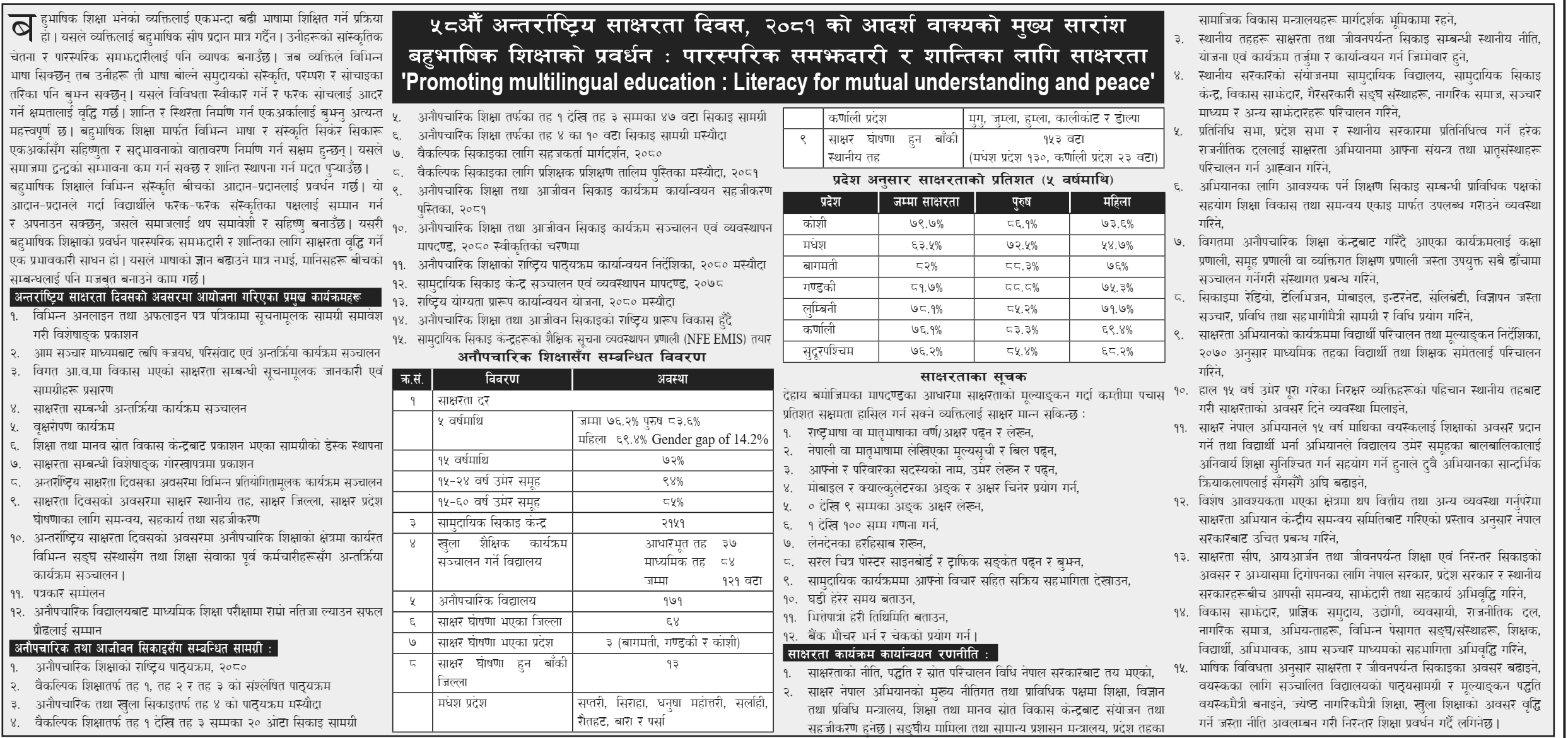
58th International Literacy Day 2024: Promoting Multilingual Education for Understanding and Peace
The 58th International Literacy Day is being observed globally on September 2024 (Bhadra 23, 2001). This year’s theme is Promoting Multilingual Education Literacy for Mutual Understanding and Peace. The day is celebrated to highlight the importance of literacy in fostering mutual understanding and peace worldwide.
Literacy Programs in Nepal
Nepal initiated its literacy efforts in 2004 BS with basic literacy programs. Over the years, various initiatives such as literacy campaigns, adult literacy programs, women’s literacy programs, and community learning centers have contributed to increasing literacy rates across the country.
Currently, several educational programs are operating under the framework of lifelong learning. These include alternative education, informal education, and open learning programs, all designed to provide flexible learning opportunities.
National Literacy Campaigns
Nepal has conducted national literacy campaigns in 2065 and 2069 BS. In 2067/068, a household survey gathered data on illiteracy, leading to the launch of an intensive literacy program in all districts by 2072 BS. From 2071 BS onwards, districts with at least 95% literacy among people aged 15-60 began to be declared literate.
By 2076 BS, 64 districts were declared literate, and three provinces—Koshi, Bagmati, and Gandaki—achieved full literacy status. The overall literacy rate for individuals aged 5 years and older is currently 76.2%, with male literacy at 83.6% and female literacy at 69.4%. Among the 15-60 age group, literacy has reached 85%.
Remaining Districts and Current Programs
In the current fiscal year (2081/082), literacy programs are being implemented in the 13 districts that have yet to achieve full literacy. These programs are guided by 12 indicators outlined in the literacy concept paper. The government aims to declare a fully literate Nepal, continuing to implement lifelong learning programs based on past achievements and the current situation.
Constitutional Rights and Education Policies
Nepal’s Constitution guarantees the right to education for every citizen. This right is supported by the National Education Policy, Sustainable Development Goal 4, and the Compulsory and Free Education Act of 2075. Both formal and non-formal education systems play a crucial role in ensuring this right is realized.
To ensure equal access to education across Nepal’s diverse geography, it is essential to expand and strengthen non-formal education and lifelong learning programs.
Future Focus and Educational Priorities
Expanding non-formal education, improving the quality of programs, and building institutional capacity are key to achieving a literate Nepal. The involvement of all stakeholders, including UNESCO and development partners, is vital to ensuring the success of literacy initiatives. The Education and Human Resource Development Center remains committed to supporting these programs.
Providing free and compulsory education, along with quality learning opportunities, is a top priority for the government. This includes offering life skills education to citizens who are no longer of school age.
Role of Local Governments
Local governments play a central role in literacy efforts. In response to the challenges faced by certain regions, particularly in the Terai and remote areas, the government has launched a nationwide student enrollment campaign. Policies that mandate school enrollment for all children, along with programs like midday meals and scholarships, aim to reduce dropout rates and improve educational outcomes.
Advancing Towards a Fully Literate Nepal
Nepal has made significant progress in declaring municipalities and districts fully literate. As the world embraces the information age, technology-friendly literacy and skills are more important than ever. The government is working on providing education that supports both employment and self-employment, helping transform illiteracy into literacy across the country.
Achieving a fully literate Nepal is essential to fulfilling the national goal of "Prosperous Nepal, Happy Nepali." The education sector’s contributions are crucial to reaching this objective, and all citizens must work together to make this vision a reality.
Timeline of Literacy Efforts and Key Milestones in Nepal
-
2004 BS
- Nepal initiates its basic literacy programs.
-
2065 BS
- The first national literacy campaign is launched.
-
2067/068 BS
- A household survey is conducted to gather data on illiteracy across Nepal.
-
2069 BS
- The second national literacy campaign takes place.
-
2071 BS
- The practice of declaring districts with at least 95% literacy among the 15-60 age group as "literate districts" begins.
-
2072 BS
- Intensive literacy programs are implemented in all districts based on the findings from the 2067/068 BS survey.
-
2076 BS
- The "Literate Nepal Year" initiative is approved and launched.
- 64 districts are declared literate, and three provinces—Koshi, Bagmati, and Gandaki—achieve full literacy status.
- National literacy rate reaches 76.2%, with male literacy at 83.6% and female literacy at 69.4%.
-
2081/082 BS
- Literacy programs continue to be implemented in the remaining 13 districts and 153 local units that have yet to be declared literate.


